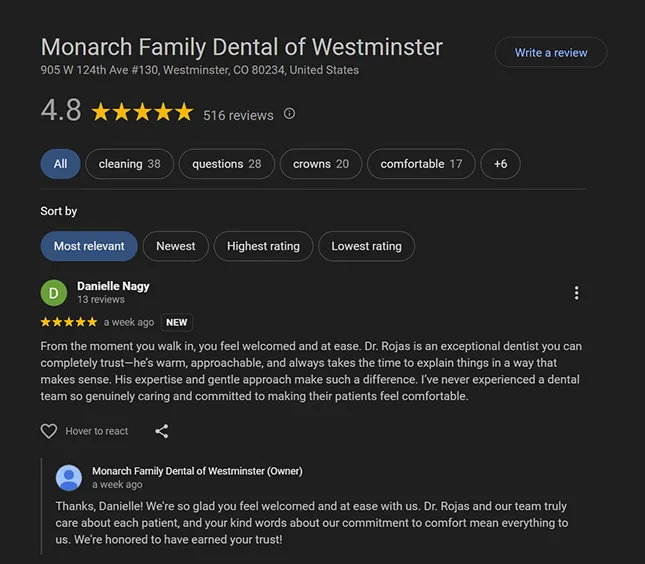When potential patients search for a dentist, they’re making a decision within seconds. If your practice isn’t showing up on that first page of Google, you’re losing patients to competitors who understand the power of search engine optimization for dentists.
The good news? You can change that starting today.
Why Your Dental Practice Needs SEO
Most dental patients aren’t driving around looking for new providers anymore. They’re searching on Google from their phones while dealing with a toothache at 10 PM, or comparing options during their lunch break at work.
These are the moments that determine whether they call your office or someone else’s.
The search engine optimization that dentists need goes beyond just having a website. It’s about making sure your practice appears exactly when someone in your area needs dental care. When done correctly, local SEO for dentists positions your practice as the obvious choice before potential patients even click through to your site. The difference between ranking first and fifth on Google can mean dozens of missed appointments each month, translating to thousands in lost revenue.
Dominating Local Search Results

Your community is your practice’s foundation, which makes local visibility absolutely critical.
When someone searches “dentist near me” or “emergency dental care” with a location, Google decides which practices to show based on specific local ranking factors. Google Business Profile optimization stands as your first priority. Your profile needs accurate information, regular posts, patient photos, and consistent responses to reviews.
Practices that actively manage their profiles see up to 70% more location visits and direction requests compared to those that neglect this free tool.
The technical side of dental local SEO matters too. Your website must include location-specific pages if you serve multiple areas, with unique content for each location that speaks to that community’s specific needs. NAP consistency (Name, Address, Phone Number) across every online directory, social media profile, and citation impacts how search engines verify and rank your practice.
One inconsistent phone number format across directories can create confusion that hurts your rankings.
Building a Website That Converts and Ranks
Dental website SEO requires balancing what search engines need with what patients want. Your site needs to load fast—within three seconds ideally—because every additional second of load time decreases patient conversions by roughly 7%.
Mobile optimization isn’t optional when over 60% of dental searches happen on smartphones.

Your website needs these essential elements:
- Dedicated service pages for each treatment (implants, whitening, emergency care)
- Fast loading speeds under three seconds
- Mobile-responsive design that works on all devices
- Clear calls-to-action on every page
- Easy-to-find contact information and appointment booking
- Patient testimonials and before/after photos
- Secure HTTPS encryption for patient trust
User experience signals tell Google whether your site satisfies searcher intent. If patients immediately bounce back to search results, that signals poor quality. Navigation should be intuitive, contact information prominent, and the appointment booking process simple.
Some practices lose half their potential patients simply because the path from landing page to appointment is too complicated.
Content That Educates and Attracts
Patient education creates opportunity for higher search rankings while building trust.
When you answer common questions through blog posts and guides, you’re creating content that matches what potential patients are actively searching for online. Someone searching “how long do dental implants last” or “is teeth whitening safe” is showing purchase intent—they’re considering these procedures.
Your content strategy should target different stages of the patient journey. Informational content like “signs you need a root canal” captures people in the awareness stage, while comparison content helps those evaluating options, and service pages convert those ready to book. This approach to dental SEO strategies creates a funnel that brings patients in and moves them toward becoming part of your practice.
Consistency matters more than frequency.
Publishing one exceptional article monthly beats posting mediocre content weekly. Each piece should offer genuine value, incorporate relevant keywords naturally, and demonstrate your expertise. The goal isn’t to trick algorithms—it’s to become the authoritative resource for dental health information in your market. That authority translates directly into higher rankings and patient trust.

Technical SEO Fundamentals for Dental Practices

Behind every well-ranking dental website runs clean technical infrastructure.
Site architecture should organize services logically, with a clear hierarchy that helps both users and search engines understand your offerings. Internal linking between related pages—like linking from your general dentistry page to specific treatment pages—distributes authority throughout your site while helping patients navigate to relevant information. Schema markup might sound technical, but it’s simply code that helps search engines understand your practice details better.
Critical technical elements for dentist SEO include:
- Schema Markup – Local Business schema tells Google your hours, location, and services, while Review schema can display star ratings directly in search results
- Page Speed Optimization – Compress images, minimize code, and invest in quality hosting to keep load times under three seconds
- HTTPS Security – Google gives preference to secure sites, and patients expect security when sharing personal information
- XML Sitemap – Helps search engines crawl and index all your important pages efficiently
- Mobile-First Design – Your site must work flawlessly on smartphones since most searches happen on mobile devices
Many dental practices ignore schema markup entirely, creating an easy opportunity for you to gain competitive advantage. These dentist website SEO elements work together to create the foundation that supports all your other optimization efforts.
Building Authority Through Strategic Links and Reviews

Your practice’s online reputation directly impacts search rankings.
Google considers review quantity, quality, and recency when determining local rankings. Practices with 50+ positive reviews typically outrank similar practices with fewer reviews. Create a systematic process for requesting reviews from satisfied patients, but never incentivize or fake reviews—penalties aren’t worth the risk.
Patient testimonials on your website serve double duty: they convince prospects and provide fresh, user-generated content that search engines value. Video testimonials work particularly well, as they’re authentic, engaging, and increase time spent on your site—another positive ranking signal.
Link building for dental practices focuses on local relevance and quality over quantity. Local business partnerships, dental associations, community event sponsorships, and local news features all generate valuable backlinks. One link from your local chamber of commerce website carries more weight than dozens from irrelevant directories.
Reputation management extends beyond just collecting positive reviews.
Responding professionally to negative reviews shows potential patients how you handle concerns. Many patients judge practices more on how they respond to criticism than on the criticism itself. Turn negative experiences into opportunities to demonstrate your commitment to patient satisfaction.
Measuring Success and Adjusting Strategy

Effective dental SEO requires ongoing monitoring and refinement. Track keyword rankings for your target terms, but focus more on meaningful metrics like organic traffic, phone calls, form submissions, and actual new patient appointments.
A practice ranking first for “cosmetic dentistry” but receiving no appointments has an optimization problem beyond rankings.
Google Analytics reveals which pages attract traffic, where patients drop off, and which content resonates most. Google Search Console shows which keywords drive impressions and clicks, plus identifies technical issues affecting your site. These tools provide the data needed to make informed decisions about where to invest your optimization efforts.
If your implant dentistry page gets significant traffic but few conversions, that page needs better calls-to-action or more convincing content—not more traffic.
Search algorithms evolve constantly, and what worked last year might not work today. Staying current with dental SEO best practices ensures your practice maintains and improves its rankings over time. Major algorithm updates can shift rankings overnight, but practices built on solid fundamentals—great user experience, quality content, and genuine authority—weather these changes better than those relying on shortcuts.
Growing Your Practice Through Strategic SEO
SEO for dentists isn’t a one-time project—it’s an ongoing investment in your practice’s digital presence.
The practices winning online right now didn’t get there overnight. They committed to consistent optimization, patient-focused content, and building genuine authority in their communities. These same strategies work whether you’re a solo practitioner or managing multiple dental offices.
The patients searching for dentists right now won’t wait for you to figure out search engine optimization for dentists. They’re clicking through to well-optimized practices, reading reviews, and booking appointments with your competitors.
Every day you delay is another day of lost opportunity and revenue.
Ready to implement a comprehensive SEO strategy that actually brings patients through your door? The Nozak Consulting team specializes in helping dental practices dominate their local search results and attract more qualified patients. We’ve helped dentists across the country increase their online visibility and grow their practices through proven SEO keywords for dentists and strategic optimization. Schedule a call with our team today and let’s develop a customized plan to grow your practice through search engine optimization.
